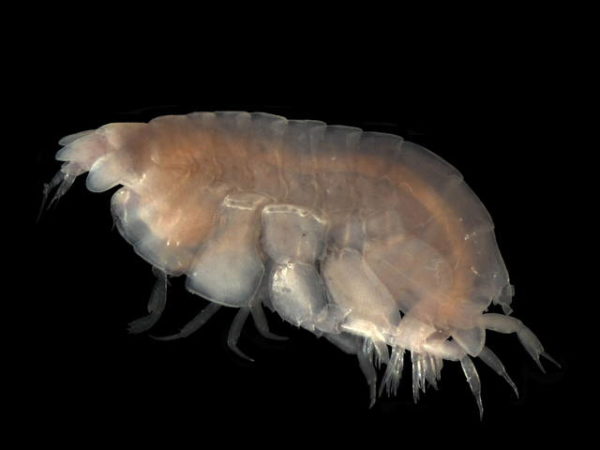Published in the Ocean Watch column, Honolulu Star-Advertiser © Susan Scott
September 2, 2017
Bloody attack! Mysterious sea creatures! A taste for human flesh! Unstoppable bleeding … And so went the sensational terms describing an injury sustained by a 16-year-old Australian boy last month.
 Lysianassoid amphipods, above, created an internet sensation
Lysianassoid amphipods, above, created an internet sensation
when they nibbled on a teen’s feet in the waters at an Australian beach
last month. The crustaceans known as sand fleas or sea lice are recyclers
of the seas, usually choosing to feast upon dead plants and animals.
Courtesy Wikimedia
Having sore leg muscles after a football game, Sam stood with his ankles in the water off a southern Australian beach. The 60-degree water numbed the teen’s skin, and when he emerged, blood oozed from multiple tiny bites.
When the teen’s father posted gory pictures of his son’s feet on Facebook, people got so overly excited you would have thought the kid got shredded by Freddie Kruger. In fact, the 16-year-old had pinprick lesions from a bunch of amphipods just doing their job.
Amphipods are crustaceans, an enormous group of shelled animals including shrimp, lobsters, crabs, barnacles and more. The ocean hosts 8,000 amphipod species with 2,000 more living in brackish and fresh water. Amphipod relatives are isopods and copepods, also with thousands of species each.
In biology, “pod” means feet, and the various prefixes above describe differences in the creatures’ limbs.
Although fleas and lice are insects, and amphipods are not, people often call amphipods sand fleas or sea lice.
The average amphipod is about a half-inch long. Some species, though, are barely visible to the naked eye, and one rare deep-sea species grows to 13 inches.
One of these huge amphipods, appropriately named gigantea, was found in the stomach of a black-footed albatross, one of Hawaii’s seabirds. Researchers believed the huge amphipod was already dead when the bird ate it. Check out this colossal crustacean at goo.gl/XdLhKF.
Most amphipods swim the world’s oceans eating dead plants and animals, making them outstanding recyclers. So, yes, amphipods eat animal flesh, but the creatures are neither parasites nor carnivores. Rather, most are omnivores, eating whatever they find, such as the Australian teen’s feet and ankles.
Sam’s immobility attracted his neighborhood amphipods, and since he couldn’t feel their nips in the cold water, he allowed them to keep biting.
Most amphipods use claw-tipped front legs to eat, cutting food off in tiny pieces and delivering it to the mouth. The creatures have no venom and are not medically dangerous. Had the parents elevated Sam’s feet and put a bit of pressure on the lesions, the bleeding would have stopped. But then the oceans’ sanitation engineers known as amphipods wouldn’t have had their 15 minutes of fame.
An Australian biologist identified the animals that munched on the boy’s feet as lysianassoid amphipods, a family that specializes in recycling. Some reporters, however, erroneously placed the creatures in the Kruger family of Elm Street.